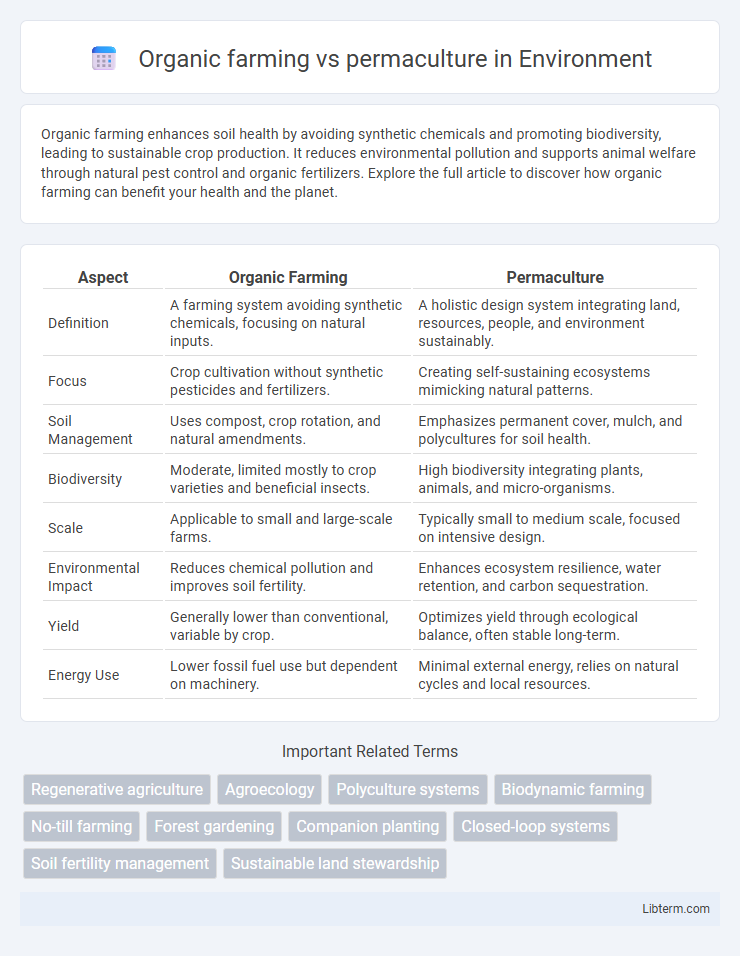Organic farming enhances soil health by avoiding synthetic chemicals and promoting biodiversity, leading to sustainable crop production. It reduces environmental pollution and supports animal welfare through natural pest control and organic fertilizers. Explore the full article to discover how organic farming can benefit your health and the planet.
Table of Comparison
| Aspect | Organic Farming | Permaculture |
|---|---|---|
| Definition | A farming system avoiding synthetic chemicals, focusing on natural inputs. | A holistic design system integrating land, resources, people, and environment sustainably. |
| Focus | Crop cultivation without synthetic pesticides and fertilizers. | Creating self-sustaining ecosystems mimicking natural patterns. |
| Soil Management | Uses compost, crop rotation, and natural amendments. | Emphasizes permanent cover, mulch, and polycultures for soil health. |
| Biodiversity | Moderate, limited mostly to crop varieties and beneficial insects. | High biodiversity integrating plants, animals, and micro-organisms. |
| Scale | Applicable to small and large-scale farms. | Typically small to medium scale, focused on intensive design. |
| Environmental Impact | Reduces chemical pollution and improves soil fertility. | Enhances ecosystem resilience, water retention, and carbon sequestration. |
| Yield | Generally lower than conventional, variable by crop. | Optimizes yield through ecological balance, often stable long-term. |
| Energy Use | Lower fossil fuel use but dependent on machinery. | Minimal external energy, relies on natural cycles and local resources. |
Introduction to Organic Farming and Permaculture
Organic farming prioritizes natural inputs and processes, avoiding synthetic pesticides and fertilizers to promote soil health and biodiversity. Permaculture integrates agricultural practices with sustainable design principles, creating self-sufficient ecosystems that mimic natural patterns. Both methods emphasize environmental stewardship, but permaculture extends beyond farming to encompass holistic land management and resource conservation.
Defining Organic Farming: Principles and Practices
Organic farming emphasizes methods that avoid synthetic chemicals, genetically modified organisms, and artificial fertilizers, prioritizing natural inputs and ecological balance. Key principles include maintaining soil health through crop rotation, composting, and biological pest control, which promote biodiversity and sustainable land use. This approach aligns with strict certification standards designed to ensure the integrity of organic products in global markets.
Understanding Permaculture: Core Concepts and Ethics
Permaculture emphasizes designing sustainable agricultural systems that mimic natural ecosystems by integrating land, resources, people, and the environment. Core concepts include care for the earth, care for people, and fair share, ensuring resource conservation and social equity through ethical principles. Unlike organic farming, which primarily focuses on chemical-free cultivation, permaculture deeply integrates holistic ecological design and long-term sustainability ethics.
Key Differences Between Organic Farming and Permaculture
Organic farming prioritizes the avoidance of synthetic chemicals and emphasizes crop rotation, natural pest control, and soil fertility enhancement through organic inputs, focusing mainly on crop production. Permaculture integrates sustainable agriculture with ecosystem design, combining plants, animals, water, and landscape to create self-sufficient, regenerative systems that mimic natural habitats. While organic farming addresses chemical use and soil health in agriculture, permaculture encompasses a holistic approach to land management that includes energy conservation, biodiversity, and community resilience.
Soil Health and Fertility Management
Organic farming improves soil health by avoiding synthetic chemicals and relying on crop rotation, compost, and green manure to enhance fertility. Permaculture emphasizes creating a self-sustaining ecosystem with diverse plants and animals that naturally recycle nutrients and build rich, living soil. Both methods prioritize soil biology, but permaculture integrates more permanent, multi-layered plant systems to maintain long-term soil structure and fertility.
Biodiversity and Ecosystem Integration
Organic farming enhances biodiversity by avoiding synthetic chemicals and promoting crop rotation, which supports beneficial insects and soil microorganisms. Permaculture integrates diverse plant and animal species within a self-sustaining ecosystem, mimicking natural processes to maintain soil health and water cycles. The holistic design of permaculture systems leads to greater ecosystem integration compared to organic farming, fostering resilient habitats and continuous nutrient recycling.
Water Use and Conservation Methods
Organic farming emphasizes efficient water use by avoiding synthetic chemicals and enhancing soil organic matter to improve water retention and reduce runoff. Permaculture integrates water conservation through techniques like swales, rainwater harvesting, and contour planting, promoting natural water cycles and minimizing irrigation needs. Both systems prioritize sustainable water management but permaculture adopts a more holistic landscape design to optimize long-term water use efficiency.
Crop Diversity and Pest Control Strategies
Organic farming emphasizes crop diversity through rotation and intercropping to enhance soil health and reduce pest outbreaks, relying on natural predators and organic pesticides for pest control. Permaculture integrates a wider variety of perennial plants and companion planting, creating self-sustaining ecosystems that naturally manage pests through biodiversity and habitat complexity. Crop diversity in permaculture promotes resilient pest control by fostering beneficial insect populations and minimizing monoculture vulnerabilities common in conventional organic systems.
Economic and Social Impacts
Organic farming boosts local economies by creating job opportunities and supporting small-scale farmers through higher-value crop production. Permaculture enhances community resilience and social cohesion by fostering resource-sharing networks and promoting sustainable lifestyles that reduce long-term costs. Both methods contribute to economic stability and improved social welfare by emphasizing eco-friendly practices and reducing dependence on external inputs.
Choosing the Best Approach: Which Is Right for You?
Organic farming emphasizes chemical-free cultivation with a focus on soil health and crop rotation, ideal for those seeking sustainable food production with established certification standards. Permaculture integrates ecological design principles, combining diverse plant species and natural ecosystems to create self-sustaining agricultural systems, suitable for small-scale or homestead applications. Choosing between organic farming and permaculture depends on your land size, goals for biodiversity, resource availability, and commitment to ecological stewardship.
Organic farming Infographic

 libterm.com
libterm.com